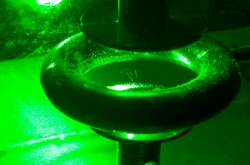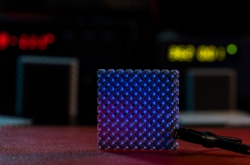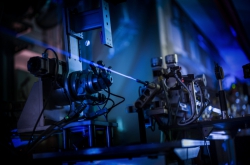Life's Unexplainable Property
"There are lots of chiral objects (those that can't be superposed on their mirror image) around us: from the microscopic ones like different organic and inorganic molecules to macroscopic ones like spiral galaxies. Fossils of some shellfish, human feet or palms, even a common screw — all of those things are chiral. So, chirality is widespread in both living organisms and inanimate nature", explains Ivan Rukhlenko, head of the Laboratory.
According to the scientist, dimensional configuration of molecules can be left- and right-sided. As biomolecules are chiral, their interactions with organisms greatly depend on it. This is essential, as hundreds of drugs used in modern pharmacology are enantiomers (basically, mirror images of each other). Two of such chiral "reflections" can have different properties: a "left-sided" substance can have a positive effect in treating a disease, while the "right-sided" one can be lethal. Thus, in the 60s thalidomide was prescribed to pregnant women for morning sickness. Then, the scientists didn't pay attention that thalidomide has the enantiomorphism property: one type of molecules relieved the sickness, while the other caused malformations in their children. This is why it's so important to separate enantiomers and study their properties. Afterwards, different types of them are patented as separate substances. So, how can one separate molecular mixtures of different enantiomers?
 Photo credit: depositphotos.com
Photo credit: depositphotos.com
Dividing enantiomers
Separating such molecules is really hard, as enantiomers have identical chemical and physical properties — so all the usual methods don't work with them. So, the only way to separating them is using other chiral objects. A 1:1 mixture of enantiomers is called racemic mixture, and has no chiral properties. And if it chemically reacts with a compound that consists of homochiral molecules, then the resulting substances will be diastereomers. They will no longer have equal physical properties — so it will be possible to separate them using common methods like centrifugation. Still, first you'll have to convert the substance into something else, then restore it — and the sequence of chemical reactions is unique for every substance.
For example, there is the chiral chromatography method. For it, a fixed phase is used — a silica gel prepared using chiral sugars. The racemic mixture is distilled through a vertical column with the gel, so that one of the phases is slowed down. This way, we first get one enriched phase, and then the other. Still, such method requires immense skill, notes Ivan Rukhlenko.
"It's really hard find the fixed phase for a particular substance. So that's a long way of trial and error. Also, one has to pick the necessary conditions for the reaction, as well. And the method is of no use to industry, as drugs have to be completely enantiomerically pure. Another problem is that it's sometimes hard to define, which of the separated enantiomers is safe", — explains the scientist.
 Photo credit: weacom.ru
Photo credit: weacom.ru
Using nanocrystals
The simplest chiral object in optics is circularly polarized light twisted into a spiral. Still, molecules aren't good at interacting with light. They are a lot smaller than the wavelength of the light they absorb, and they have few atoms, so optical pressure is not enough to divide molecules. Also, the Brownian movement mixes them too fast. Still, we can create semiconductor nanocrystals that are chiral as well. Those have a lot more atoms, so their interaction with light is stronger. Hence, nanocrystals can be used for separating enantiomers of drug molecules, as well as for identifying them with sensors.
"How to use nanocrystals in sensors or for separating enantiomers? If we separate the crystals using light, or any other method, we can selectively add them to chiral molecules. Then, after separating free molecules and molecules with nanocrystals using light or magnetic fields, we will be able to separate the racemic mixture. Then all what's left is cleaning the molecules from nanocrystals; the crystals can be re-used then. As for the sensors, it is even easier: after reacting with a substance, nanocrystals change their optical response, which tells us of the substance's enantiomeric configuration", notes Ivan Rukhlenko.
 ITMO University. Ivan Rukhlenko and Nikita Teplyakov
ITMO University. Ivan Rukhlenko and Nikita Teplyakov
Still, what are the ways to separating nanocrystals with different defects? Or how to intensify their interaction with light? The scientists presented their results in two journals in this May and June. For the article published in Journal of Applied Physics, Nikita Teplyakov was the main author.
"If we assume that originally, a nanocrystal is not chiral, then we can say that a small perturbation of its electrical subsystem is what makes it chiral. Nikita elaborated a theory that allows to describe the optical activity of such nanocrystals with small perturbation. It modifies the nanocrystals' wave functions. This theory can be applied to nanocrystals with different chirality types — technically, it can be applied to molecules, as well", explains Ivan Rukhlenko.
The second article, published in Optics Letters, was on the general approach to analyzing the optical activity of chiral semiconductor crystals. According to Ivan Rukhlenko, the article allows to calculate the asymmetry of interactions and derive end formulas. To do that, one has to know the equations for the wave functions and the energy distribution of charge carriers inside the nanocrystal. That is only possible with the simpler forms of nanocrystals — cubes, blocks, spheres or cylinders. A chiral nanocrystal is a lot more complex.
"We've devised a method for coordinates conversion that transforms irregular, slightly chiral nanocrystals into an ideal nano-cuboid. And we know the wave functions for it. So, as we know the wave functions and the energy distribution of charge carriers, we know everything of the quantum system and can calculate any of its properties. This article has been marked out by the editor of Optics Letters, who wrote a small note expressing hope that our theory will soon be confirmed by experimental data", notes Ivan Rukhnenko.
Experimental issues
 Nanocrystals. Photo credit: saitnovostey.ru
Nanocrystals. Photo credit: saitnovostey.ru
Getting experimental evidence is no easy task, as it's very hard to separate nanocrystals of different shape. If one has 50% nanocrystals of one shape and 50% of the other, they won't be generally active in the racemic mixture. It's possible to see their shapes using different microscopic methods, but to study them properly, one has to work with separate crystals. This is hard, as the optical response of a single nanocrystal is very weak. So, it's easier to study the nanocrystals as some mass. In cases of particular deformations, strong optical activities emerge, which can allow to separate the crystals using optical radiation. In order to study electromagnetic fields that can be used for separating nanocrystals, Ivan Rukhlenko applied for a national grant. Still, getting some practical results will require even more funds than the grant can give, notes the scientist.
This method was used on molybdenite, and the experiment data supported Nikita Teplyakov’s theory: after exfoliation by ultrasound, a piece of this substance breaks into atomic and diatomic layers, which, in presence of chiral molecules, twist into odd shapes.





